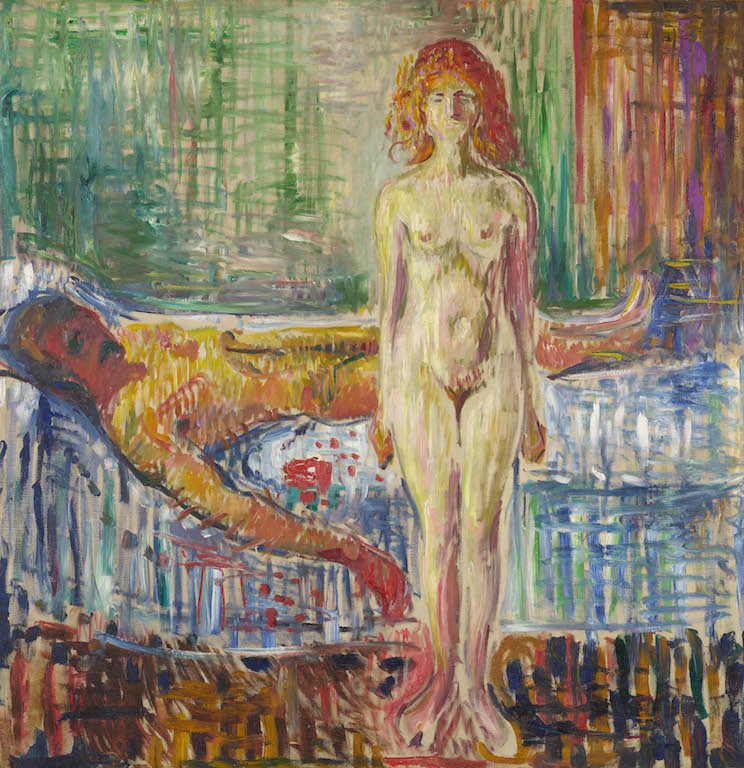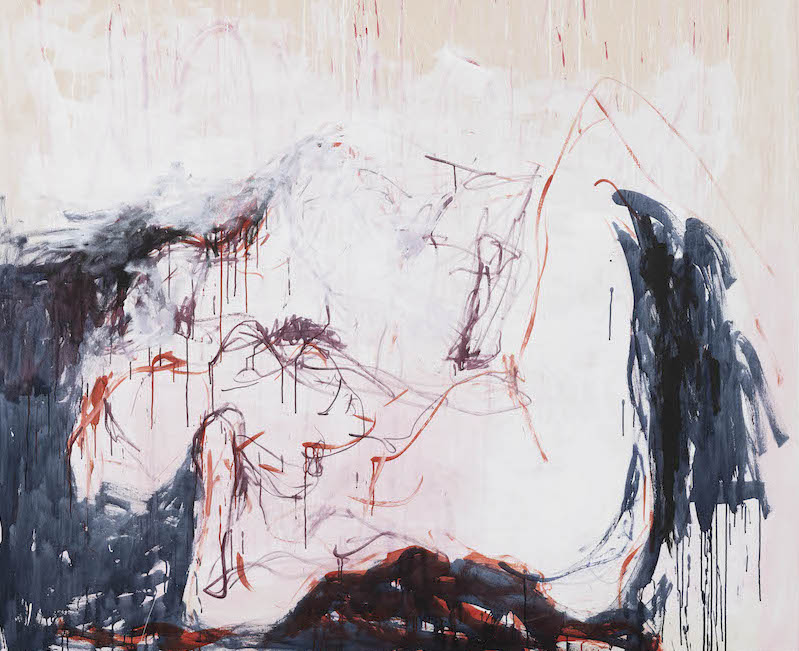Even before going to art school, Tracey Emin discovered the work of the Norwegian expressionist Edvard Munch. And even though he was born 100 years before her, she embraced him as a kindred spirit. One can see why. Whether painting figures, buildings or landscapes, Munch projects onto his subjects the intense feelings of desolation, loneliness and abandonment which haunted him most of his life.
When he was just five, his mother died of TB, his favourite sister following nine years later. Brought up by a neurotic father obsessed with death, he recalled an unhappy childhood in which, “The angels of fear, sorrow and death stood by my side since the day I was born.” And his most famous painting, The Scream (1893) is like an interminable howl of despair.
Emin is similarly preoccupied with loss; in her work she grapples with a pervading sense of solitude brought about failed relationships, the deaths of her parents and the abortion of her twin foetuses. On paper, then, the idea behind the Royal Academy's exhibition of juxtaposing their work looks extremely promising. In reality, though, it just doesn’t work. Neither artist benefits from the presence of the other and, for the viewer, the experience is simply confusing.
 Confronted by similar subject matter tackled in very different ways, I found it impossible to switch my gaze from her work to his, and back again. The problem is partly one of scale – her paintings are huge, while his are modest in size. More importantly, though, it’s a question of perspective. Emin’s paintings are of herself, either alone (main picture) or with a lover and, to accompany them, she has chosen paintings by Munch that are also of solitary women or couples. The similarity ends there, though.
Confronted by similar subject matter tackled in very different ways, I found it impossible to switch my gaze from her work to his, and back again. The problem is partly one of scale – her paintings are huge, while his are modest in size. More importantly, though, it’s a question of perspective. Emin’s paintings are of herself, either alone (main picture) or with a lover and, to accompany them, she has chosen paintings by Munch that are also of solitary women or couples. The similarity ends there, though.
Emin’s figures are painted from the imagination. She has no traditional drawing skills so avoids challenges like faces, hands and feet; instead, she produces generalised impressions of bodies delineated by spindly outlines. The results are often incoherent and have very little physical substance; they seem more like phantoms, memories or mirages than solid flesh and blood.
This is no loss, though, since her nervous, spiky lines communicate a deep sense of emotional and physical fragility; her figures feel as if they are on the verge of a nervous breakdown, about to crack up. This impression is exacerbated by the veils of colour that, washed in with rapid brush strokes, surround and often overwhelm the figures like floods of emotion welling up uncontrollably. Cascading down the canvas, meanwhile, are myriad dribbles suggestive of tears. The paintings are literally and metaphorically outpourings. Despite her subject matter, in other words, her pictorial language is almost more abstract than figurative. And she employs it to speak in the first person about her experience of inhabiting a female body.
By contrast, the women Munch portrays are models posing for him – bodies seen from the outside. His Crouching Nude 1917-19 (pictured above), is rapidly sketched in with fluid lines that create a convincing sense of solidity; you feel the weight of her presence. She lies curled in the foetal position, as though anxious or scared, surrounded by a wash of pinkish red that, like many of Munch’s backgrounds, suggests an unstoppable flow of blood. The white of her skin is offset with pale turquoise contours that create a chilling sense of vulnerability; she looks cold, alone and very mortal. These are projections, of course. Munch is not mapping her emotional landscape, but his own. We know nothing about her; she is merely a cypher and, as such, remains mute – other. A similar discrepancy exists between Munch’s The Death of Marat, 1907 (pictured above) and Emin’s painting Because You Kept Touching Me, 2019 (pictured below), which shows a couple intertwined to the point where they become a single entity. This tangle of limbs makes sense only if you imagine yourself within it, probably with eyes closed. The experience described seems more about touch than looking – the feel of a lover’s skin, the solace of contact, the memory of an intimate embrace.
A similar discrepancy exists between Munch’s The Death of Marat, 1907 (pictured above) and Emin’s painting Because You Kept Touching Me, 2019 (pictured below), which shows a couple intertwined to the point where they become a single entity. This tangle of limbs makes sense only if you imagine yourself within it, probably with eyes closed. The experience described seems more about touch than looking – the feel of a lover’s skin, the solace of contact, the memory of an intimate embrace.
Munch similarly recounts the painful experience of an emotional break-up, but at one remove. Ostensibly his painting depicts the murder, in 1793, of French revolutionary, Jean-Paul Marat by his political enemy Charlotte Corday. A man lies prone on a bed while a woman stands stiffly by his side, facing us; both are naked. There’s no sign of a weapon or a struggle and the scene feels more like a post-coital stand-off than a murder. Her body is rigid and her face is set in a mask of bitterness or resentment.  The title is a blind, of course; the man is a self-portrait and the woman Munch’s erstwhile fiancée, Tulla Larsen. The blood dripping from his hand refers to an incident that sparked the break-up of their relationship – his gun accidentally going off and wounding him. He is dealing in metaphors; a physical wound for an emotional one – a bleeding hand for a bleeding heart – while an actual death acts as the surrogate for a psychological one. And while the protagonists seem frozen – he lies inert while she stands as stiffly as a statue – their emotional turmoil is projected onto the background, which is ablaze with rapid fire brush marks that make everything seem unstable.
The title is a blind, of course; the man is a self-portrait and the woman Munch’s erstwhile fiancée, Tulla Larsen. The blood dripping from his hand refers to an incident that sparked the break-up of their relationship – his gun accidentally going off and wounding him. He is dealing in metaphors; a physical wound for an emotional one – a bleeding hand for a bleeding heart – while an actual death acts as the surrogate for a psychological one. And while the protagonists seem frozen – he lies inert while she stands as stiffly as a statue – their emotional turmoil is projected onto the background, which is ablaze with rapid fire brush marks that make everything seem unstable.
Both artists explore similar emotional terrain, but their approach is profoundly different. While Munch distances himself, Emin speaks directly from the heart. While he displaces his hurt by projecting it onto others, she revisits her feelings through the immediacy of the act of painting. That’s why it’s so difficult to switch from looking at his work to engaging with hers, and vice versa.
- Tracey Emin / Edvard Munch: The Loneliness of the Soul at the Royal Academy to 28 February
- More visual arts reviews on theartsdesk










![SEX MONEY RACE RELIGION [2016] by Gilbert and George. Installation shot of Gilbert & George 21ST CENTURY PICTURES Hayward Gallery](/sites/default/files/styles/thumbnail_125_x_125_/public/mastimages/Gilbert%20%26%20George_%2021ST%20CENTURY%20PICTURES.%20SEX%20MONEY%20RACE%20RELIGION%20%5B2016%5D.%20Photo_%20Mark%20Blower.%20Courtesy%20of%20the%20Gilbert%20%26%20George%20and%20the%20Hayward%20Gallery._0.jpg?itok=3oW-Y84i)




Add comment